It is not unusual for people new to outdoor trekking to innocently ask:
What should I bring?
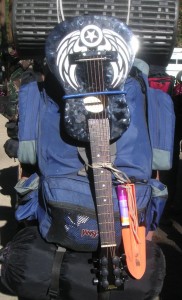 Even experienced trekkers are likely to stumble before this open-ended totally-depends how-much-time-do-you-really-have question. The requester probably just wants a simple check list of gear and yet there is so much more. What should I bring? may trigger:
Even experienced trekkers are likely to stumble before this open-ended totally-depends how-much-time-do-you-really-have question. The requester probably just wants a simple check list of gear and yet there is so much more. What should I bring? may trigger:
- Less than you think.
- Why, what do you have?
- Where are you going?
- How long are you going?
Or simply:
- Bring me!
How do you satisfactorily respond to a questions whose only answer is: it depends? Rather than providing the definitive list you find yourself discussing all the conscious and unconscious tradeoffs that come with that one word depends. Every item chosen potentially pushes another worthy item out.
Certainly we can put in a another day’s supply of food. Would you like to get rid of the rain fly or the first aid kit? I think fishing gear is a great idea. Should we get rid of your book or your camera?

Yes there are a variety of gear lists which can and should be shared. They represent the collective experience, priorities, and previous decisions of those providing you the list. To widen your access to wisdom you may want to examine multiple lists, looking for common themes and priorities that align with your own.
I once knew a guy who always carried a huge D-battery Maglite. Yes the same one the police carry and can use as a riot stick to take down a three hundred pound drunk. When I asked how he could justify carrying such a heavy and bulky light his answer was simple.
I am responsible for the safety of the youth I lead on these wilderness outings and we spend half our time in the dark. If something seriously goes wrong, I am not going to be depending on some stupid little pen light.
I am not suggesting that we all should carry monster Maglites, but I do appreciate his passion and the clarity of his priorities.
The Problem
Here are some basic rules of thumb which illustrate the problem.
Weight: Target Backpack Weight = 25% to 30% of your body weight.
If you weigh 150 lbs, your loaded pack should weigh between 37.5 lbs and 45 lbs. If you are a 13 year old boy weighing all of 90 lbs soaking wet, your loaded pack should only weigh between 22.5 lbs and 27 lbs.
Bulk: Even if you can manage the weight, the size of your backpack will determine the volume of space you have.
- Small Pack (40-50 Liters – 1 to 2 Nights)
- Medium Pack (50-65 Liters – 3 to 5 Nights)
- Large Pack (65-80 Liters – 5+ Nights)
To manage the weight and the bulk some pretty tough priority decisions are going to have to be made.
Outdoor Hierarchy of Needs
One way to start considering your own priorities is to think in terms of a hierarchy of needs. Your needs may vary, but mine goes pretty much like this:
- Air
- Water
- Food
- Shelter
- Support
- Luxury
Setting the word depends aside for a moment, there is an expression that is at least illustratively true:
You can go 3 minutes without air, 3 days without water, and 3 weeks without food.
Clearly the need for air is more immediate than the need for food, and the need for shelter is more immediate than the need for luxury.
Air
When traveling in the wilderness, you are likely to find a readily available supply of high quality air. However, for those with asthma or serious allergies, accessing it may become an issue. Make sure medication, inhalers and Epi-pens are being carried by those who may need them, and that everyone else on the trip knows where they are and how to administer them.
Water
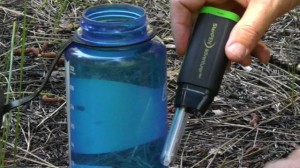
Unless you are going on an extremely short trek, you will not be carrying as much water as you need. This means in addition to the couple of quarts per person you are carrying, you need to be carrying a way to purify additional water. This may be by boiling, filtering, chemically treating, or zapping with a ultraviolet light.

Food
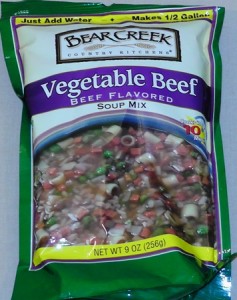
Participating in high adventure activities you may burn between 3,000 – 5,000 calories per day. How you replenish these calories will be up to you. What you ultimately select will have an impact on weight and bulk, but you should probably count on somewhere in the neighborhood of 1.5 to 2 lbs of food per person per day. Some ultra light backpackers target 1 lb per person per day. To get 3000K in 1 lb of food takes some creativity, and a frankly a fair amount of fat.
Shelter
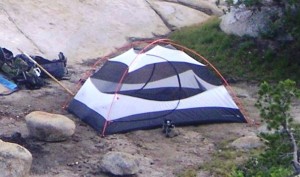
Keeping dry and warm is critical to your health and well being. How you provide that to your body can be thought of as shelter. Proper clothing and rain gear may play a part, but most people think of shelter as where they will sleep. This will include choices about tarps, insulation pads, sleeping bags, and tents. In survival or primitive situations, it may mean snow caves or debris piles.
Support

Support items are the things that help you provide the “higher up” hierarchy needs. It might be things like first aid kits, utility knives, cooking stoves or pots and pans. Depending on what you pick for the higher items will increase or decrease what you need for support.
Luxury

You may think that by the time you care for all the other hierarchy needs there will be no room for luxury. But don’t forget that even on the TV show Survivor contestants were allowed to bring one luxury item. Depending on how you have done in the other categories will determine how much weight and bulk you can allocate. It may be a simple as a deck of playing cards, a small Frisbee, a paperback book, fishing tackle, or that plastic coffee press. Enjoying yourself in the wilderness is the reason you go, and if there are items that will greatly enhance your pleasure they are worth figuring out how to bring along.
Bull’s Eye Packing
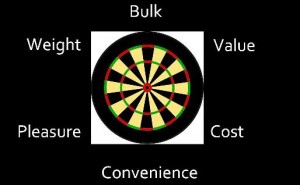
There are a variety of factors, conscious or unconscious, which help us determine if we include or exclude a particular item from our packing list. In many cases, there is a tradeoff inter-dependency between the criteria. For example, the heavy pot may be less expensive than the lighter pot. The bulky sleeping bag may be less expensive than the highly compressible one.
Our goal is to find the holy grail. To find those items which meet all of our criteria, putting them smack dab in middle: the bull’s eye items.
Criteria Based Examples
Although you will probably never get this mathematical or anal retentive in your approach, looking at a few examples may help illustrate the mental process. I will score each item 1 to 3, with 3 being the most positive score, and 1 being the most negative. In other words, high value would score 3 (excellent) , but high weight would score 1 (poor).
1 = poor, 2=good, 3=excellent
| Water Treatment | Wt | Bk | Va | $ | Cv | Pl |
| Boiling | 2 | 2 | 3 | 2 | 1 | 2 |
| Chemical | 3 | 3 | 2 | 3 | 2 | 1 |
| Filter | 2 | 2 | 2 | 1 | 3 | 3 |
| UV Light | 3 | 3 | 3 | 1 | 3 | 2 |
Using water treatment as an example, boiling scores high for value because it is very effective, even against viruses. It scores low on convenience because you either have to be at camp or set up a stove along the trail. Chemical treatment is very inexpensive, light and not bulky, but the taste is absolutely awful. Pleasure scores very poor.
| Pants | Wt | Bk | Va | $ | Cv | Pl |
| Blue Jeans | 1 | 1 | 2 | 3 | 1 | 1 |
| Hiking Pants | 3 | 3 | 3 | 2 | 3 | 3 |
Blue Jeans are inexpensive, especially considering you probably already have several pairs sitting around at home. Denim however is bulky and heavy, a poor insulator, and gets even worse when wet. Denim take forever to dry. Hiking pants are light, compact, and dry quickly.
For each item you are considering on your personal gear list, make sure you test them against these basic criteria.
Playing Nice With Others

One often overlooked aspect of packing is group gear. More times than I can count, inexperienced backpackers have shown up with completely full packs, and no room for group gear. How much room each person will need for group gear depends on your groups gear strategy. Are you sharing everything except clothes and personal items? Are you sharing food, stoves, pots, pans, pumps, shelters? Depending on the strategy, each person may need from between 40-60% of their load capacity for group gear.

Loved the table approach (with 1, 2, 3) for each of the choices, but could you publish a key for what the terms across the top are? For example, I can guess most, but what is Cv?
Thanks for the comment, and sorry for the confusion. The categories are from the Bulls Eye picture, but I guess I wasn’t clear:
Weight (Wt), Bulk (Bk), Value (Va), Cost ($), Convenience (Cv) and Pleasure (Pl)
Let us know what criteria you consider when packing. – rick